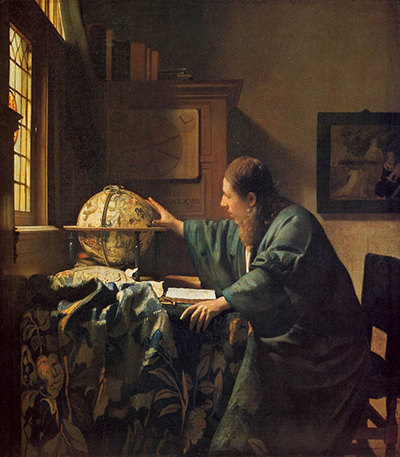Johannes Vermeer, who is thought to have completed his painting “The Astronomer” in around 1688, is today recognised as one of the great masters of seventeenth-century Dutch painting.
This was not always the case. Although he had received some recognition in his home town of Delft during his lifetime his reputation declined after his death in 1675. It was not until the middle of the nineteenth century that his work was re-evaluated and his skill and significance as an artist fully appreciated.
Only thirty-four surviving works have been definitively attributed to Vermeer and he is thought to have been a slow and meticulous worker who produced relatively paintings in his short life.
Many of these depict quiet domestic scenes, a single figure standing in a room of a house of his time, performing a simple task, surrounded by everyday objects. Vermeer’s skill as a painter enables him to take these basic ingredients and use them to create images with such gentle precision that they reveal to us the quiet beauty of these simple scenes.
Vermeer’s painting, “The Astronomer”, is often paired with his similar work, The Geographer and they are thought to be companion pieces. This is because they clearly have similar scientific themes, common among painters at this time, and they both seem to feature the same scientist at work in the same room. “The Geographer” was completed in 1688/1689 shortly after “The Astronomer”.
It has been suggested, but not proven, that the man portrayed in both paintings is Antonie van Leeuwenhoek, a contemporary of Vermeer’s. Van Leeuwenhoek was a draper who also qualified as a surveyor in 1669, the date shown on “The Geographer”. He was also a self-taught scientist and has been acknowledged to be the first microbiologist, for his study of micro-organisms and his use of microscopes. He was also appointed to be trustee of Vermeer’s estate on his death in 1675.
Many of the figures shown in Vermeer’s paintings are women although some do portray men in secondary roles. Of all his works, it is only “The Astronomer” and “The Geographer” that feature a man as the main figure.
“The Astronomer” shows the scientist seated at his table on which sits a celestial globe, believed to have been made by Jodocus Hondius, and which shows the positions of the stars and constellations in the sky. The astronomer has open, in front of him, a book which has been identified as “Institutiones Astronomicae” (“On the Investigation of the Stars”) by Adriaan Metius printed in 1621.
Also on the table is a flat astrolabe, an essential tool for navigation. At this time the Dutch seaborne empire was at its most successful and Dutch vessels crossed the oceans of the world transporting and trading in its commodities. The robe worn by the astronomer in the painting has been identified as a Japanese Rok, a garment presented as gifts to Dutch merchants on their visits to the Japanese Court.
A crumpled sheet of paper indicates that here is a man at work exploring and reaching out for knowledge just as he reaches out to the celestial globe. The astrolabe may suggest the need for a careful and measured approach to navigating the Astronomer’s journey to new knowledge and discovery. This new knowledge is also represented in the painting by the light that shines in through the window and illuminates the room and towards which the astronomer is also reaching.
On the far wall can been seen part of a painting which portrays Moses in the Bull Rushes. Moses was described as being “learned in all the wisdom of Egypt” and the Egyptians were known to be skilled in astronomy. Moses’ leadership of the Israelites during their exile led him to being referred to as the “oldest geographer” but he also represented an approach to science based on the work of the early civilisations rather than modern observation and experiment.
Vermeer’s “The Astronomer” represents the personification of this pursuit of scientific knowledge that the Dutch had embraced at this time and a more general enthusiasm for understanding the world and the wider universe that is common to all mankind.




